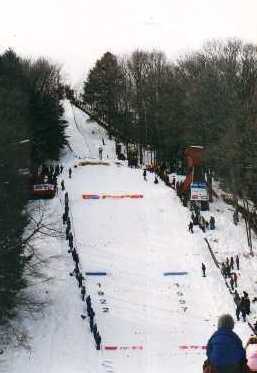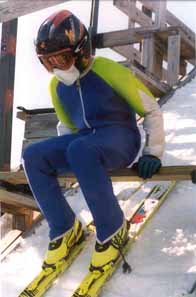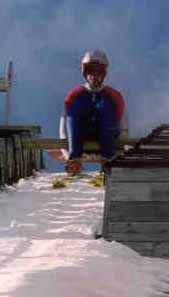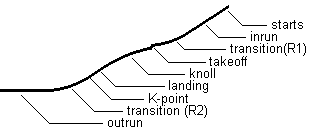|
|
MAINTAINED BY THE SKI JUMPING COMMITTEE, USSA EASTERN DIVISION |

75th anniversary competition, Feb. 1997. |
Facts about Ski Jumping hillsImpress your friends with facts and jargon about ski jumps.When you look up at the landing of a ski jump, it looks almost vertical. You can win bets from your friends by asking them to guess the steepness, you will hear guesses like sixty degrees when in fact the steepest landing hill in the eastern U.S. is only about 38 degrees, and new large hills are being built at 35 to 36 degrees. A Little Terminology: |
 |
Current practice is to use bar starts with platforms on
the side where the skiers put on their skis. The bar start has a
wooden beam or metal pipe spanning the track and supported on both
sides of the track. The skier sits on the bar and slides sideways
until he is at the center of the track. When the hill is clear, he
shifts his weight forward and settles into the track. (Check the shoelace, left.) |

|
 The skier gathers speed as he zips down the inrun to the
takeoff. The track is one half to one inch deep in hard snow. The
first part of the inrun is straight with an angle of 28 to 36 degrees. The
next section is a transition curve leading to the takeoff. This
curve is usually a circular arc and its radius is limited by the rules for
ski jump design. The radius of this curve is denoted by
R1 and because there is also a transition below the
landing, people simply refer to the inrun transition as R1 (in
the same spirit, the transition below the landing is frequently called
R2).
The skier gathers speed as he zips down the inrun to the
takeoff. The track is one half to one inch deep in hard snow. The
first part of the inrun is straight with an angle of 28 to 36 degrees. The
next section is a transition curve leading to the takeoff. This
curve is usually a circular arc and its radius is limited by the rules for
ski jump design. The radius of this curve is denoted by
R1 and because there is also a transition below the
landing, people simply refer to the inrun transition as R1 (in
the same spirit, the transition below the landing is frequently called
R2).
If you let cartoon illustrations be your guide, you might think that the takeoff shoots the ski jumper up into the air -- not so! Takeoffs actually angle downward at 7 to 12 degrees. And the track is not curved all the way to the end of the takeoff, the last section is straight. The rules for ski jump design prescribe that the length of the straight part of the takeoff (the table) be chosen so that the skier traverses it in one quarter of a second.
At the edge of the takeoff (the lip) the jumper leaps up and out in a subtle and difficult compromise between wanting maximum upward thrust and wanting never to have his body in a full vertical position. The air resistence encountered by a vertical head and chest erodes the skiers forward velocity and cuts precious meters off his jumping distance, so he tries keep the chest low and still exert great thrust with the legs.
In the old days, ski jump landings were flat just ahead of the takeoff,
then rolled over abruptly at the knoll and ran straight down to the
transition. This was bad design; today the landing will have no noticable
knoll, instead it will have one smooth curve, almost to the top of the
transition. The most recent design rules permit no straight section on the
landing.
The ski jumper flies over the landing in an aerodynamic
position, trying to get some lift from his body and skis while keeping his
foreward drag as low as possible (another compromise). The V- style
originated in the late 1980's by Swede Jan Bocloev gives jumpers increased
aerodynamic lift.
The height of a jumper above the landing depends on
the skill and style of the jumper and on the design of the hill. There are
hills where a jumper can fly 400 feet but never be higher than six feet
above the landing. On the other hand, a hill can be designed with a high
takeoff and with the landing dropping away steeply below the takeoff,
where jumpers might be more than twenty feet above the landing. First-time
specators are often surprised at how low the jumpers fly. Ideal snow
conditions on a landing hill consist of a perfectly smooth base of very
hard snow covered by a half inch to one inch of fast granular snow.
The K point on the landing marks the place where the bottom of the landing meets the top of the transition (R2). According to the rules, jumps are tolerated only a few meters past the K point. If jumpers exceed K, the takeoff speed is reduced by using a lower start. The jumpers goal, of course, is to fly as far down the hill as possible, then land gracefully and ski through the transition to come to a safe stop before the end of the outrun. Hill size is designated by the distance in meters from the takeoff to the K point. (Until just a few years ago, hill size was designated by the distance to the norm point P which is approximately 80% of the distance to K. For example, the 70 meter Olympic jump in Lake Placid became the K-86 without physical modification. In writing or conversation, people often include the "K" to make sure that it is understood that they are using the new designation.) A measuring tape is stretched from the edge of the takeoff downward through the air until it meets the knoll on a tangent. Then the tape is laid along the landing surface down to K. This tape is also used to measure the distance of each jump. The distance of a skiers jump is marked at a point directly under the ski boots when the entire skis contact the snow. The distance measurers must be careful not to be misled when the tails of the skis drag before the jumper lands.
Next, meet some great Ski Jumpers of the present and the recent past.
| [ HOME PAGE ] | [ INDEX ] | [ INSIDE INFO ] |